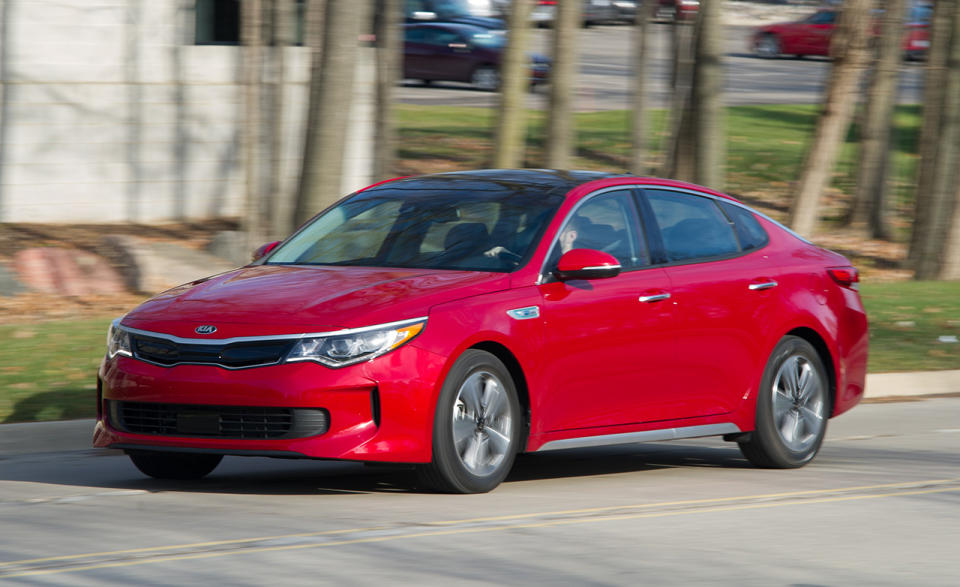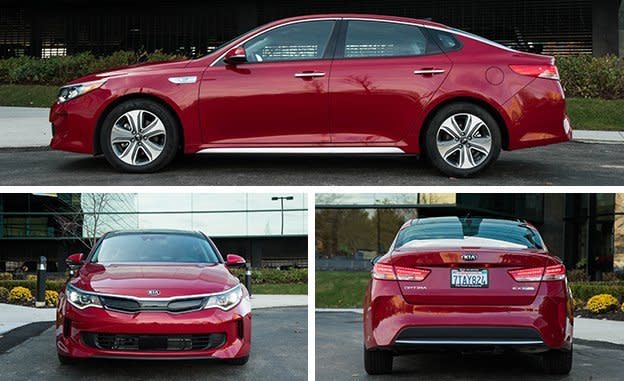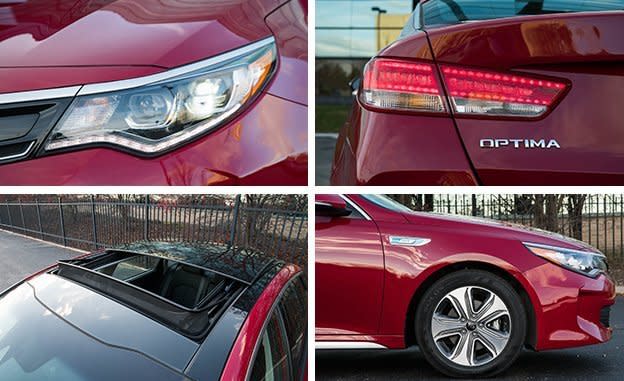2017 Kia Optima Hybrid

Kia’s U.S. operations are just over 20 years old. In that time, it has become the eighth-best-selling brand in the country, just behind corporate sibling Hyundai. If Hyundai isn’t careful, it could be surpassed by its own kin.
From behind the wheel of any Kia, though, the success isn’t surprising. From the Soul, a 10Best Trucks and SUVs winner, to the Optima hybrid tested here, Kias are rich with quality—a word that was appropriate only for sarcastic punchlines about Kia two decades ago. Similarly, the automaker produced its first hybrid only six years ago but now ranks among the industry leaders in the vehicle type.

Plus, when it comes to design, Kia is killing it. No longer does an Optima look like it’s trying too hard to stand out in a class of, let’s face it, relatively boring family sedans. It is a genuine looker with crisp lines and just enough adornment to accent its styling, like a red-carpet celebrity wearing all the right accessories. One could argue that those great looks were diluted in the process of making this hybrid variant as slippery as possible by adding grille shutters in a redesigned front fascia and tacking on aero-friendly wheels and a low-drag rear fascia. All the work nets a low 0.24 coefficient of drag, but it does scrub some of the distinction from the presentation.
Digit Discussion
A 2.0-liter Atkinson-cycle inline-four, good for 154 horsepower, and a 50-hp electric motor combine for 192 ponies when called on. Maximum combined torque of 271 lb-ft is routed through a six-speed automatic transmission to the front wheels. From a standstill, the Kia will hit 60 mph in 7.9 seconds, which is lazier by more than half a second than the class-leading Honda Accord hybrid and Toyota Camry hybrid, although the Optima never feels slow. Not that any hybrid buyers are likely to go looking for the cornering limit, but the Optima’s lateral acceleration maxes at 0.81 g. Braking from 70 mph requires 175 feet.

What stands out in the Optima isn’t the features or the performance as much as the polished execution. While Apple CarPlay, Android Auto, and a 7.0-inch infotainment interface (which grows to 8.0 inches with the EX trim level, as tested here) come standard, the real standout standard features are the throttle calibration and blending of regenerative to friction braking. These qualities are among the best among all hybrids. The sublime tuning, which more than a few calibration engineers no doubt sweated, won’t be lost on people who care more about how a car drives than its EPA rating. A Ford Fusion hybrid was in our fleet at the same time, and the Optima’s superior hybrid integration was noted with surprise by many editors.
The Optima’s powertrain layout—essentially a motor/generator and clutch taking the place of a torque convertor—is much simpler than the power-split two-motor transaxle cum CVT in the Fusion. Even without the complexity, the Kia matches the Fusion’s EPA combined score of 42 mpg. We achieved nowhere near that, however, averaging 31 mpg over almost 900 miles, or 4 mpg short of the efficiency of what we accomplished in the Chevrolet Malibu hybrid (a two-motor setup) and the Honda Accord hybrid (a two-motor, no-transmission arrangement).

Our test car came fully loaded. A base Optima hybrid starts at $26,890 and comes with manually adjustable cloth seats and 16-inch wheels. In the competitive set of hybrid family sedans, only the Fusion hybrid starts cheaper, at $26,170. Spending another $4995 on the EX trim brings leather and heat to the front seats (and power to the driver’s seat), 17-inch wheels, a 60/40 split-folding leather back seat, and a 10-speaker Harman/Kardon audio system. The only option on the EX is a $5000 Technology package. It includes ventilated front seats and a power front passenger seat, heated rear seats, a giant dual-pane sunroof, and a host of advanced safety technology features (automated emergency braking, lane-keeping assist, blind-spot monitoring, and adaptive cruise control). Kia also offers a plug-in version with a 202-hp hybrid powertrain and a 9.8-kWh battery pack that, according to Kia, allows it to travel up to 29 miles on electricity alone. It starts at $36,105 in EX trim.
The whole driving experience lacks most of the hybrid idiosyncrasies—CVT behavior, electric-motor hums—to which we’ve become accustomed. Wondering if we had lost it, we put this theory to the test by plopping an unsuspecting friend in the driver’s seat. The hybrid virgin had no clue he was driving anything but a standard Optima. That may not be what Kia was going for, but it’s a ringing endorsement for someone who wants a hybrid without any compromises to the driving experience. To us, that makes the Optima hybrid wise beyond its years.
Specifications >
VEHICLE TYPE: front-engine, front-wheel-drive, 5-passenger, 4-door sedan
PRICE AS TESTED: $36,885 (base price: $26,890)
POWERTRAIN: DOHC 16-valve Atkinson-cycle 2.0-liter inline-4, 154 hp, 140 lb-ft; permanent-magnet synchronous AC motor, 50 hp, 151 lb-ft; combined output, 192 hp, 271 lb-ft; 1.6-kWh lithium-ion battery pack
TRANSMISSION: 6-speed automatic with manual shifting mode
DIMENSIONS:
Wheelbase: 110.4 in
Length: 191.1 in
Width: 73.2 in Height: 57.5 in
Passenger volume: 105 cu ft
Trunk volume: 13 cu ft
Curb weight: 3640 lb
C/D TEST RESULTS:
Zero to 60 mph: 7.9 sec
Zero to 100 mph: 21.7 sec
Zero to 120 mph: 35.8 sec
Rolling start, 5–60 mph: 8.2 sec
Top gear, 30–50 mph: 3.9 sec
Top gear, 50–70 mph: 5.3 sec
Standing ¼-mile: 16.1 sec @ 88 mph
Top speed: 123 mph (governor limited)
Braking, 70–0 mph: 175 ft
Roadholding, 300-ft-dia skidpad: 0.81 g
FUEL ECONOMY:
EPA combined/city/highway driving: 42/39/46 mpg
C/D observed: 31 mpg

 Yahoo Autos
Yahoo Autos 